As the famous saying goes; one person’s trash is another’s treasure. Let’s take a look at the mountains of discarded plastic that have been 3D printed into amazing products, how it’s done, and the printers and products you can use to get your initiative started.
But first, let’s look at how additive manufacturing is ideally positioned to not only raise awareness of how plastic waste can be repurposed but also to become a big part of the solution.
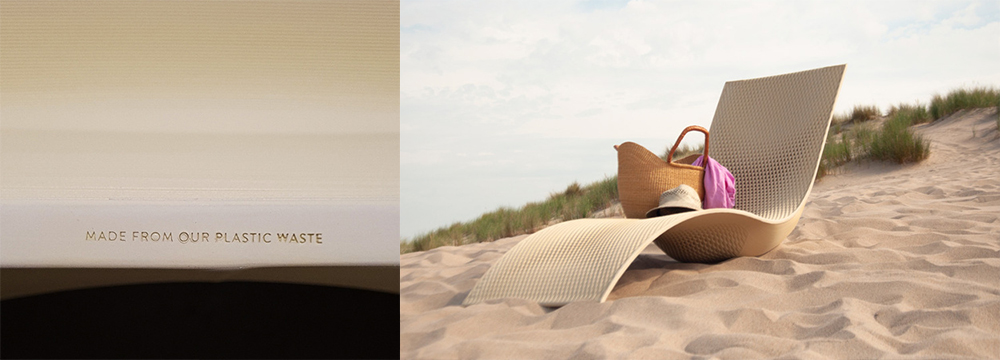
Earlier in 2023, circular design company Supernova used ReFlow’s recycled fishing net filament to 3D print 80 outdoor planters for a sustainable street project in Milan. There are more projects more often as the number of 3D printers on the market equipped to print directly with recycled plastic pellets and shreds grows.

As with most things having to do with sustainability, recycling, and environmental preservation today, practices will really change as a result of regulation and public pressure, of which there is a growing amount. The EU and some states in the US have set recycling targets for 2030 or sooner. Additive manufacturing has the potential to play a large role. The ability to profit from the practice will also be a driving factor in its adoption, and there are plenty of companies today doing just that.
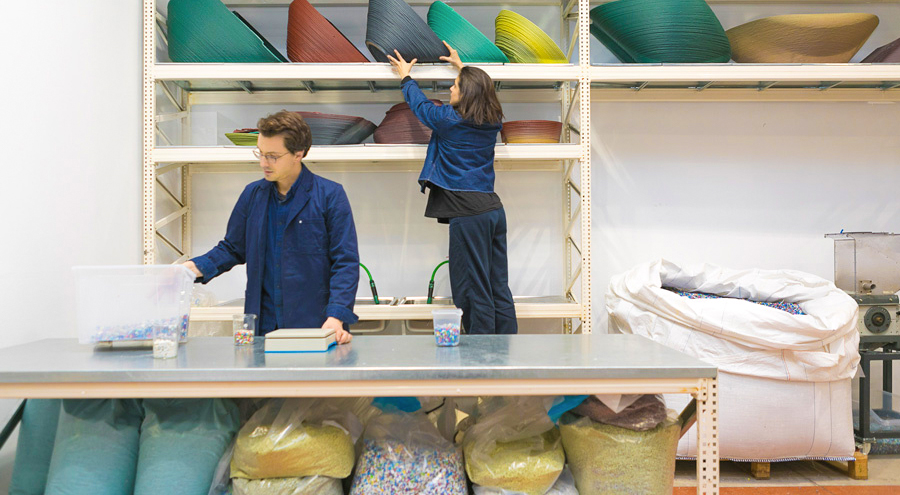
Let’s take a look and how to print with waste plastic and who’s doing it now.
How to Make 3D Printing Material from Plastic Waste
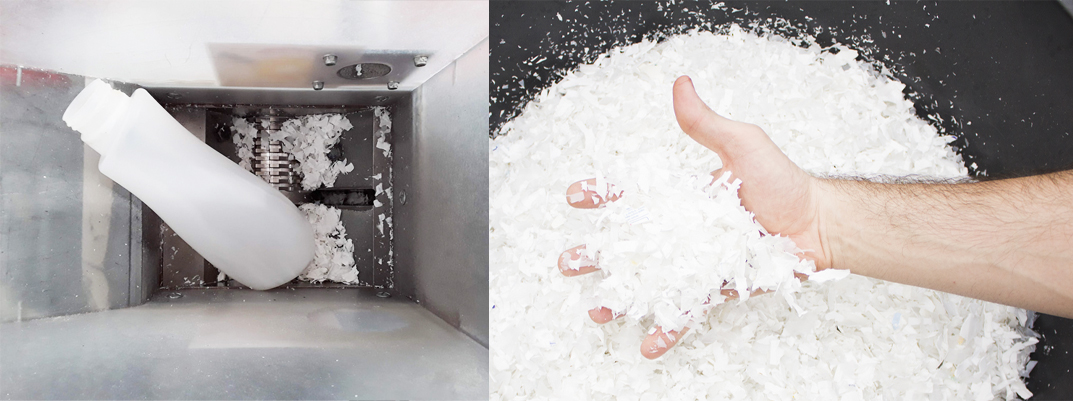
The process to make useful products out of local waste plastic through 3D printing is fairly straightforward. Known as distributed recycling and additive manufacturing or DRAM for short, it follows these steps:
- Collect plastic waste.
- Sort the waste according to type and clean it.
- Grind or shred the waste into plastic bits.
- Extrude the bits into 3D printing filament or feed them directly into a 3D printer equipped with a material hopper.
- Print a product.
This process – carried out on an industrial level or at home – enables you to create an incredibly wide range of perfectly functional products from plastic waste; everything from lamp shades to manufacturing tools. In fact, any product or part that an FDM printer can create, can be printed with waste plastic.
The filament made with this method is incredibly cheap yet retains almost all of the same qualities as virgin plastic. It enables you to print objects at a cost 1,000 times less than if you used commercial polymer filaments, according to research by Aubrey L. Woern (et al) at the Michigan Technological University.
Another study in France found that even with the time and labor involved in collecting post-consumer plastic waste and turning it into 3D printing filament, a 3D printing business can still be profitable.

In this pilot project, packaging used to protect sensitive components – such as loudspeakers and sensors – is now being collected and sorted by type. Shredders then break down this plastic blister packaging into bits and it’s dried. A filament maker from 3devo then heats the shredded plastic up to 450 °C and extrudes it in the form of plastic filament. This is then the raw material for the 3D printers that produce precision-fit assembly aids for vehicle production.
“The 3D filament printing pilot project is another example of how we are always developing new solutions to move closer, one step at a time, to our ultimate goal of achieving a completely sustainable automotive production process,” says Achim Diehlmann, Audi’s head of corporate environmental protection.
Let’s take a look at other successful projects that prove the concept and benefits of 3D printing with plastic waste.
Plastic Trash to Interior Architecture
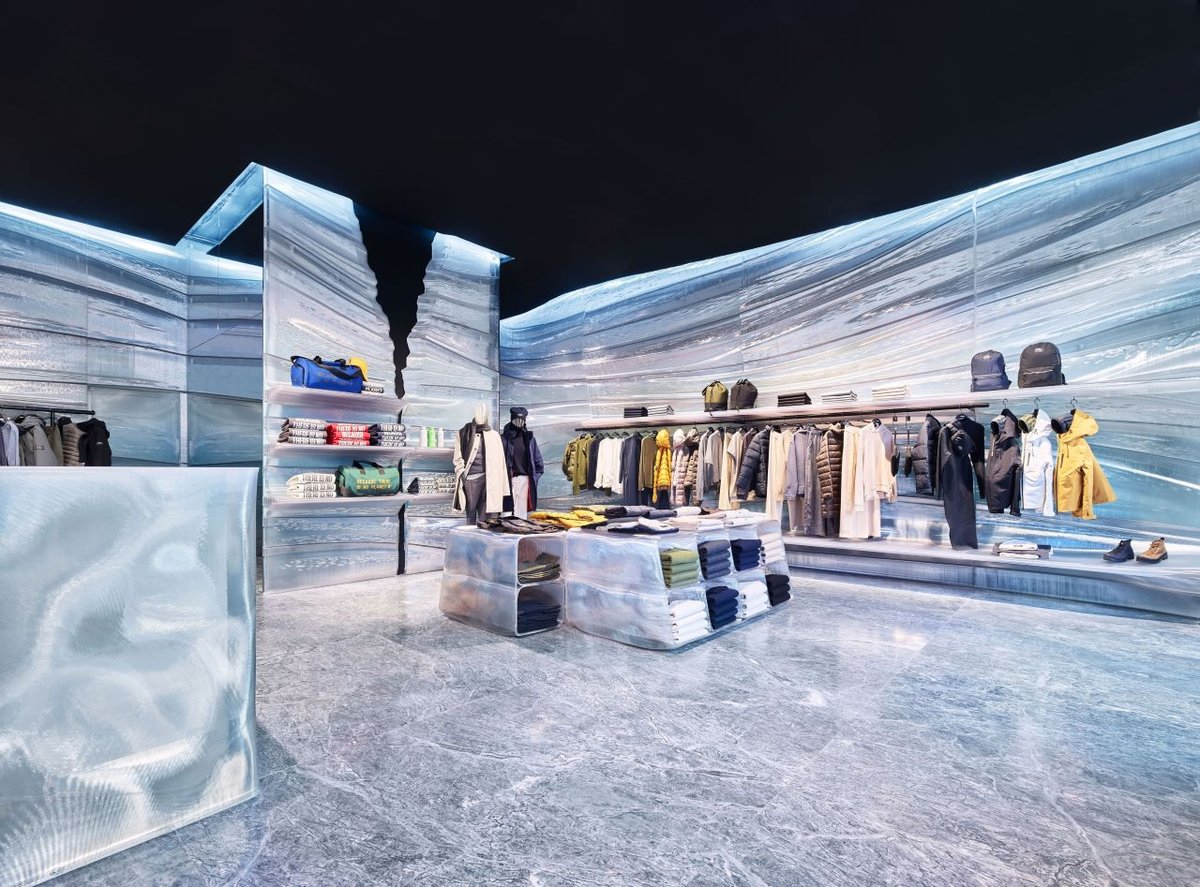
Sustainable fashion brand Ecoalf has opened a new store in Las Rozas Village, Madrid, which features a stunning 3D printed interior made entirely from recycled PETG plastic collected as trash from hospitals.
Created in partnership with Nagami design studio, the permanent installation represents a melting glacier, providing a powerful visual reminder of the urgent need for action on climate change. The walls, shelves, and display tables in the store are also made from recycled plastic, providing a second life for 3.3 tons of the material that can also be recycled at the end of its life. The installation, which took one month to manufacture with four robotic arm 3D printers, showcases the company’s clothing, footwear, and accessories, which are also made from recycled and low-impact materials.
The Ecoalf store and its 3D printed installation are part of the brand’s commitment to reducing waste and promoting sustainability in the fashion industry. By producing the store’s interior using 100% recycled plastic, Ecoalf is helping to create cleaner and more sustainable production chains that have a lower impact on the environment. The entire store is also recyclable, further reducing its environmental impact.
The collaboration between Ecoalf and Nagami design studio is a testament to the power of combining design and technology to create solutions to the world’s most pressing environmental challenges. The 3D printed installation not only serves as a striking visual representation of the consequences of climate change, but also demonstrates how 3D printing can be used to produce large-scale products from recycled materials, by showcasing the possibilities of sustainable architecture and design.
Lamps Crafted from CDs and Fishing Nets

Signify, formerly known as Philips Lighting, is no stranger to 3D printing. On the Philips MyCreation platform, customers can choose from a wide selection of beautifully designed and 3D printed lamps made from recyclable plastics and even customize their own via the Lightolier configurator.
With the “Coastal breeze” and “Radiant soundwaves” special collections, the lighting giant is now addressing the pressing plastic waste problem by using filament from discarded fishing nets and CDs, respectively. For the award-winning Coastal breeze line, the company uses 100% recycled fishing nets from Fishy Filaments, who in turn source them from the harbors of the coast of Cornwall. The Radiant soundwaves collection also consists of 100% recycled materials according to Signify but is made of 70% discarded CDs.
Recyclable and 3D printed only at request, these lamps have circularity and waste reduction baked into their DNA.
From Drinking Cartons to Furniture

Aectual and Tetra Pak have collaborated on a sustainable circular solution for interior design furniture, making use of the approximately 192 billion drink carton packages sold by Tetra Pak annually. The drinking cartons consist of 75% cardboard and 25% polymer-aluminum mix, or “PolyAl”, which is used as the raw ingredient for Aectual’s 3D printing material.
PolyAI has a clay-like appearance and texture, which allows for a variety of patterns and shapes to be created. Aectual’s interior solutions, including wall systems, planters, screens, and seating elements, come in 11 standard colors and can be customized via a digital configurator. Tetra Pak pledged to have all of its offices around the globe equipped with Aectual’s interior solutions, which is definitely one of the more creative ways for a company to take accountability for its products.
All products are 3D printed on demand, which eliminates the need for stock and excess waste. At the end of their lives, the products can even be returned to Aectual to be transformed into new products. On top of that, you will receive 5% cash back and a 25% discount on your next purchase.
Aectual’s mission is to accelerate the creation of fully circular interiors and buildings, and their collaboration with Tetra Pak is a positive step towards this goal. The company also manufactures products from single-material recyclate like polypropylene as can be seen in the title image of this article. However, this collaboration is quite remarkable as it provides a solution for composite materials which in conventional waste processing are notoriously difficult to recycle.
Tiny Homes from Plastic Waste
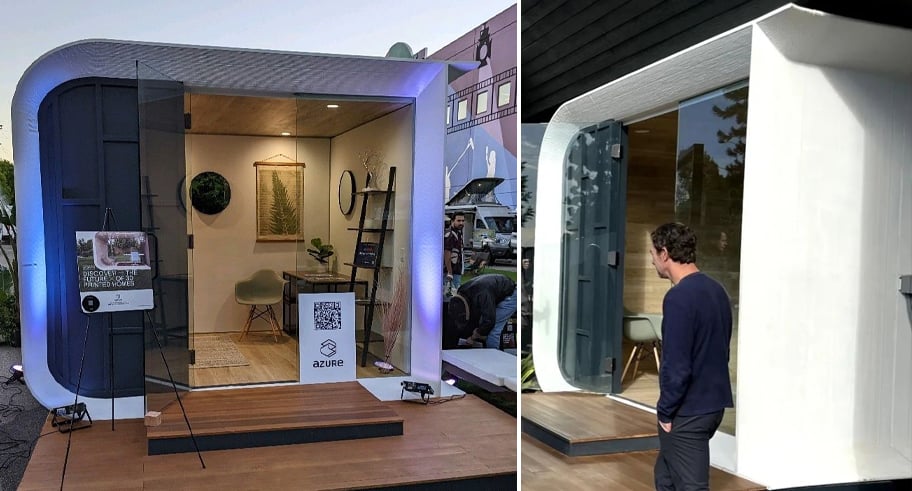
Start-up Azure Printed Homes says more than 60% of its print material comes from recycled plastic, which is used for the roof, floor, and walls of its backyard studio structures and accessory dwelling units.
These homes are meant to serve as second or third units on residential properties with an existing home, offering affordable housing to renters and giving homeowners a new revenue stream in place of a backyard or driveway.
Even though it just opened its 15,000 sq. foot home 3D printing factory in early 2022, Azure says it has already received over $16 million in preorders and plans to deliver in 2023. One order, from Californian real estate firm ReInhabit, is for fourteen 3D printed homes it plans to rent out.
The backyard homes range from studios (180 sq. ft.) to 2-bedroom units (900 sq. ft.) with a few options in between. The studios are the most affordable at $43,900 with larger homes costing between $85,900 and $204,900.
Azure’s factory-built approach to 3D printing homes from recycled plastic allows for a faster prefabrication timeline of a complete housing unit. Azure can print its modules in one day, from the floors to the walls, to the roof. The company expects the waitlist for units of 180 sq. ft. to take three months to fulfill, at which point they’ll begin production on the larger units.
Plastic Bottles to Olympic Podiums
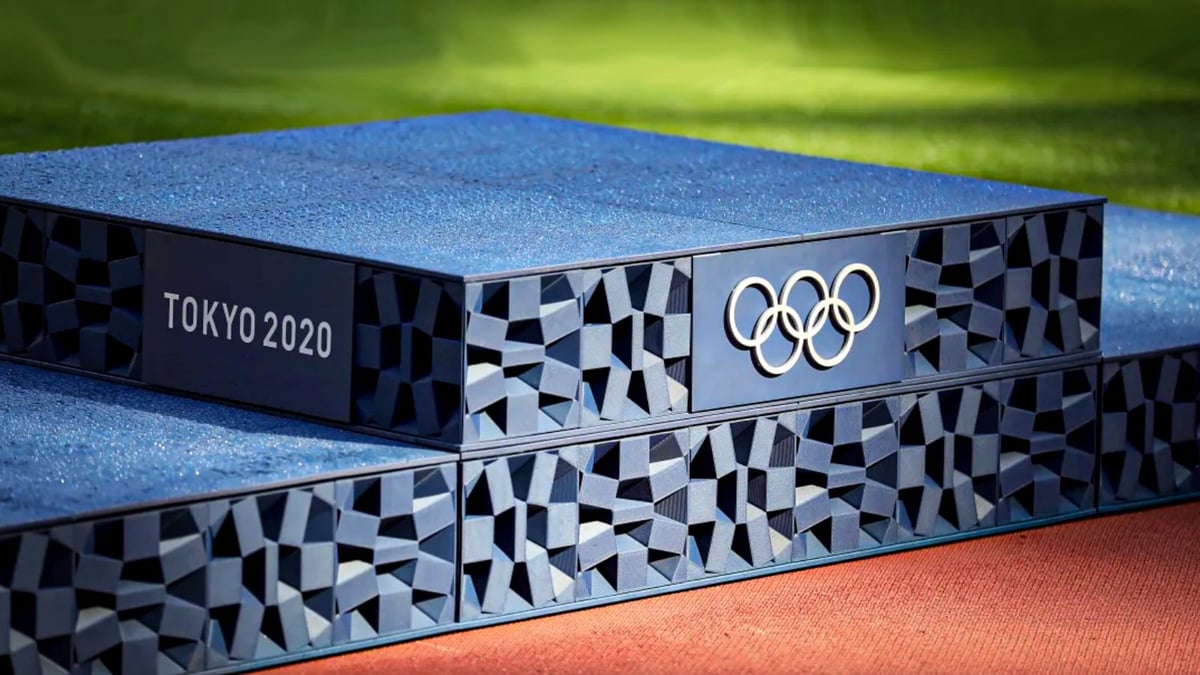
Unnoticed by almost everyone, recycled plastic took the center stage at the 2020 Tokyo Olympics where each of the 98 podiums on which Olympic winners received their medals was 3D printed from plastic waste.
The material for the podiums was donated by Japanese citizens over the past two years in a program sponsored by consumer goods giant Proctor & Gamble. More than 2,000 collection boxes were installed across the country to receive empty drink bottles, shampoo containers, and other plastic waste. Some waste was also fished out from the seas surrounding Japan.
Printing the podiums not only reduced waste, but each of them also cut 75 grams out of carbon emissions associated with the plastics used to make them. After the games, some of the podiums’ plastic will be used for educating the public about sustainability, while the majority will be recycled again into packaging for P&G products.
Plastic Waste to Plastic Waste Bins
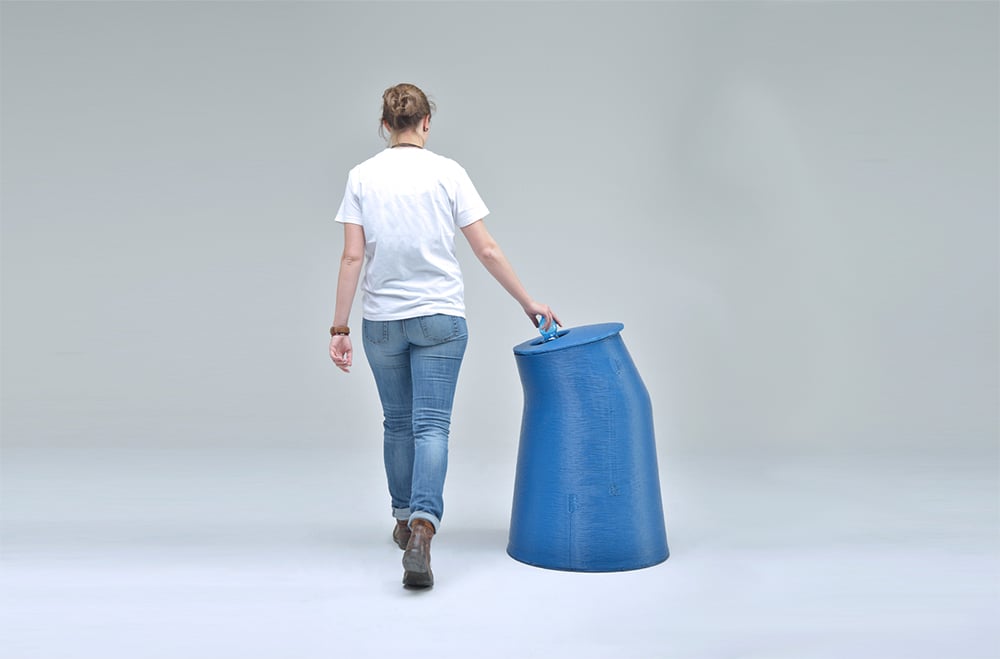
How about collecting plastic waste in trash cans made from that same waste? Italian design company R3direct does that, and more, with 3D printing. The company has one stated aim: To design and 3D print products from plastic waste. The company’s customer list is getting longer every year for everything from public art made from local waste plastics to practical urban furniture.
Italian furniture design firm Matrix International commissioned R3direct to 3D scan a sofa originally designed by Folke Jansson in 1955, then 3D print it from recycled plastic for the Milan Design Week 2021. The upholstery was created from recycled polyester. R3direct’s Pandora’s Vase lamp was also among the finalists at the 2020 Guiltlessplastic design competition.
R3direct says that their printing technology can use plastic granules immediately after shredding, skipping the filament extrusion step. This allows them to further cut energy consumption and CO₂ emissions with their plastic waste 3D printed furniture.
Fish Nets to Fancy Seats

The New Raw, an initiative based in the Netherlands, created the Second Nature series of chairs made from marine plastic in collaboration with Blue Cycle, a Greek initiative that aims to reuse marine plastic waste generated from shipping and fishing activities.
The New Raw also teamed up with the Coca-Cola Company to run the Zero Waste Future program in Thessaloniki, Greece. Consumers would bring their own plastic waste to the program’s Zero Waste Lab, which featured a plastic recycling unit and a robotic arm printer, to create customized modern furniture. One furniture series created through the partnership is called Elements and includes a sunbed, dressing room, and footpath, all printed from upcycled marine plastic waste. What better way to showcase the potential of plastic waste recycling than enabling people to enjoy a clean beach while reclining on a sunbed made from the stuff that previously polluted the waters.
The New Raw has been running the Print Your City program in several metro areas that enables locals to recycle their plastic waste and can choose how to repurpose their plastic, with a robotic 3D-printing process that can transform the sorted plastic into street furniture.
Music Fest Waste to Commemorative Sunglass Frames
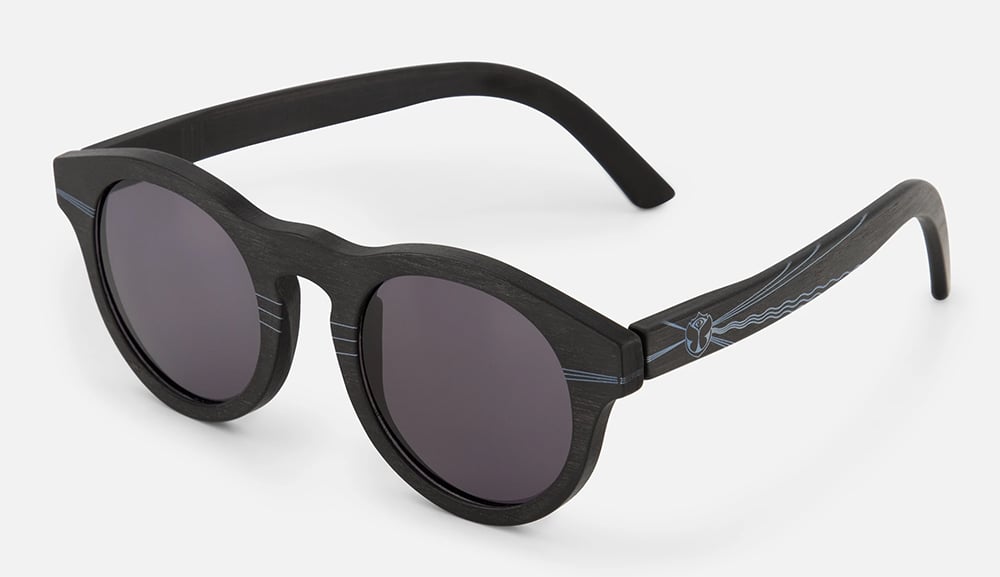
Belgium-based company Yuma Labs encourages everyone to participate in transforming our economies into the circular model. For their part, the company is turning plastic waste into fashionable, premium sunglasses.
Yuma Labs uses both powder bed 3D printing and injection molding to make their sunglasses. Their raw material comes from recycled soda bottles and bio-based nylon. The sunglasses are also fully recyclable, meaning that they can be put into further use after they’ve served their purpose.
Yuma Labs partners with companies, cities, and events, such as the Tomorrowland music festival to collect plastic waste generated at the event and 3D print custom sunglasses from it that can then be sold to event attendees to cover the cost of the plastic collection.
Yuma Labs also arranges and participates in public events to raise awareness of recycling. For example, in 2019, they organized an event at the Stormkop playground in Antwerp where children got to dredge up waste plastics from a nearby river that the company then 3D printed into children’s sunglasses at the event.
As Yuma Labs itself says, the operation isn’t just about making sunglasses or recycling plastic. They hope to inspire a broader shift towards a circular economy with their example.
Coffee Industry Waste to Coffee Bar
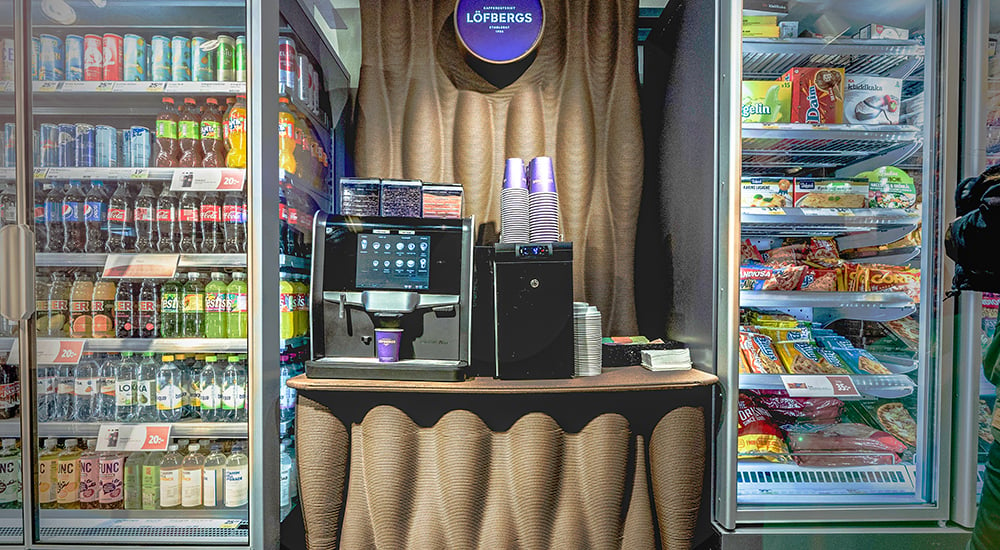
Swedish coffee group Löfbergs is collaborating with 3D print entrepreneur Sculptur to transform coffee production waste into brand new coffee stations. The collaboration is part of the Circular Coffee Community commitment and the pursuit of the group’s ambition of zero coffee waste by 2030. The world’s first 3D printed waste-based coffee station is already in operation and more are underway.
The coffee stations are 3D printed by Sculptur with a robotic 3D printer from a bi-product from the coffee roasting process and polypropylene. Further development will enable the company to use polypropylene from recycled coffee big bags making the coffee stations close to 100% circular.
“Our new coffee station is a prime example of circularity – upcycling leftovers from the processing of our own primary raw material, coffee – to create a brand-new and related sustainable product,” says Löfbergs’s Chief Innovation and Circular Transformation Officer Lars Aaen Thøgersen.
Sculptur’s products are 100% circular, and their vision is to expand this thinking to, well, everything. They’re realistic, however, and understand that they can’t do so alone. Sculptur is calling on all companies to do their part for circular conversion.
Army Base Waste to Readiness Parts
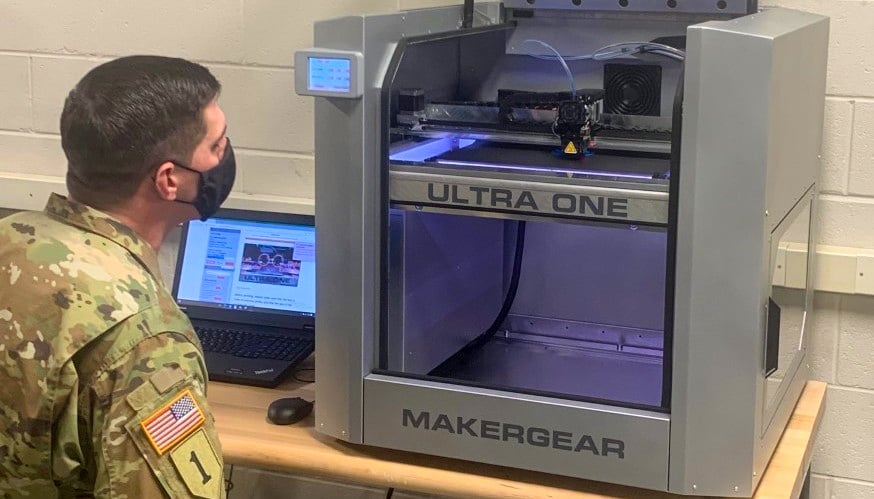
Last year, the US Army Research Laboratory launched an initiative centered around using plastic waste to 3D print essential tools and parts in the field. Although environmental consciousness is an element of the work, the real aim is to make remote bases self-sufficient and less dependent on supply chains.
The US Army already 3D prints a wide range of parts in the field, so adding the recycled materials element seemed obvious.
In frontline environments, plastic debris, such as empty water bottles, milk jugs, and yogurt containers, pile up and cause a logistical burden on soldiers to dispose of, but now the material can be used as fodder for 3D printers.
In one example, the lab 3D printed a vehicle bracket, which commonly breaks, in just two hours from 10 empty plastic water bottles. Typically the broken part would mean a new $200 part is ordered and would take months to arrive.
The project is also experimenting with recycling other material for 3D printing including items than can be added to plastics to create composite materials, such as cardboard and wood.
Local Trash to Beautiful Objects

If you want to know how to take just about any plastic waste from your local environment and make money by 3D printing it into useful and attractive objects that environmentally conscious people will want to buy, look no further than Canadian company The Rogerie as a model.
The recycled products company removes waste from the environment through small Canadian suppliers, who pull waste from landfills and oceans. Their 3D printed product catalog features, among other things, mugs, bathroom accessories, teapots, and a wide range of planters. Their customers feel good about their purchases because they are directly contributing to pulling plastic waste out of their local environment.
Think of the possibilities for just about any gift shop in the world to 3D print from local plastic waste and sell beautiful souvenirs to tourists who want to help solve the local pollution problem.
The Rogerie says they’re constantly on the lookout for new waste streams, and also offer their own recycling program. They’ll use anything from old TVs to food packaging and car parts.
All of The Rogerie’s products can be recycled further. To ensure 100% sustainability of their operation, they make sure to use only renewable energy. Unfortunately for non-Canadians, The Rogerie doesn’t offer international delivery (to eliminate emissions from product shipping). Instead, they encourage others to find similar local operations or start reducing and repurposing plastic waste in their own areas.
Coffee Stirrers to Chandeliers
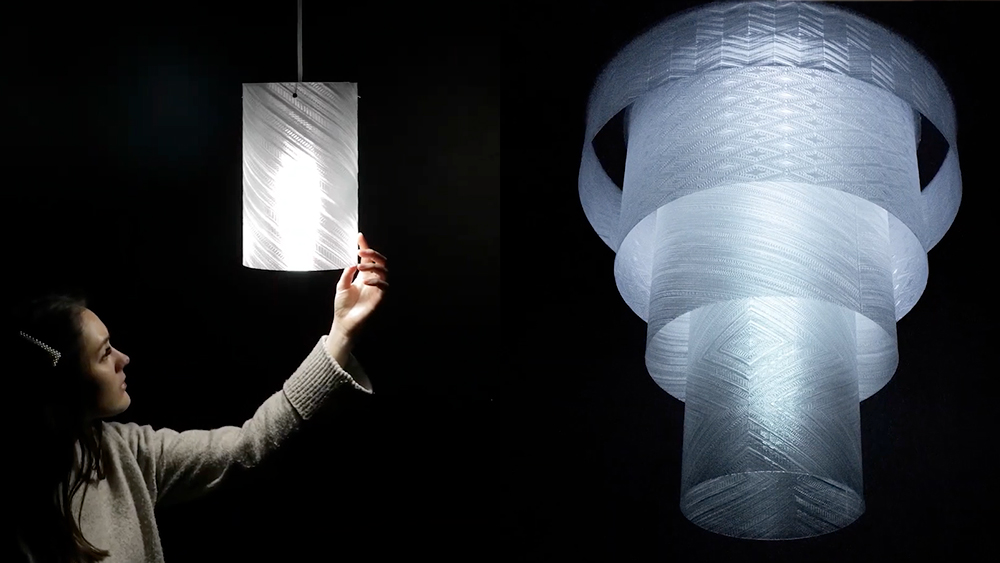
The Utilize Project has turned discarded coffee stirrers into chandeliers, soft plastics into woven-look baskets, and fishing gear into chairs, all using an oven and a desktop 3D printer from Ultimaker.
More than a design studio, Utilize specializes in helping companies uncover circular initiatives and sustainable product possibilities. Having worked with a range of waste materials in their journey, they aim to help businesses reduce, reuse, and recycle with 3D printing.
“The biggest surprise was how many types of waste we could use – soft plastics, organics, polypropylenes, and polyethylenes – we kind of questioned, why isn’t everyone doing this?” said Utilize Project founder Matthew O’Hagan in a Stuff magazine interview. “Why isn’t this being done?”
3D Printers That Print Directly with Shreds & Pellets
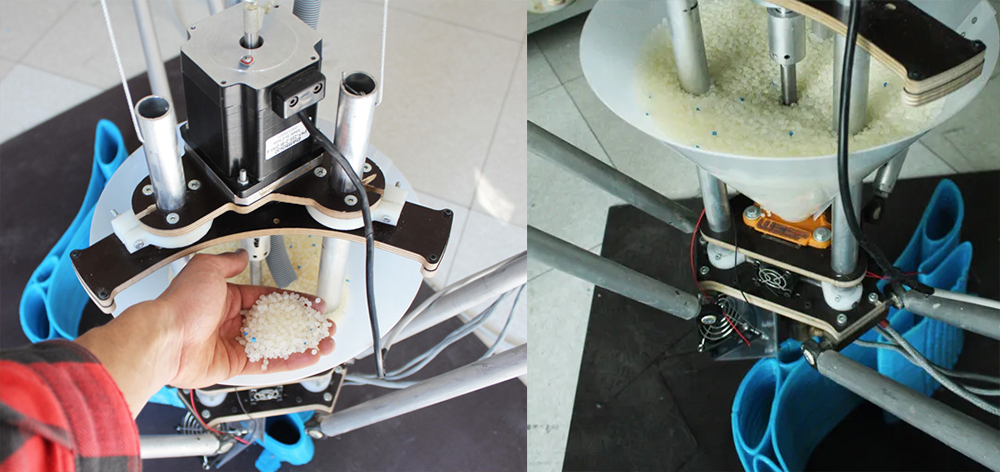
More and more 3D printers today can print directly with raw shredded plastic or bulk plastic pellets. This effectively makes materials cheaper since it saves on an extra production step, but also because the market for pellets, also known as resins, is enormous. Many plastics manufacturing technologies like injection molding use them, so there are a lot of material manufacturers justling for a share of the pellet pie. And while this practice has long been an economical solution for companies that 3D print many or large objects, today it offers anyone who 3D prints a sustainable option as well.
Essentially, these printers have a vat or hopper where you feed the raw material in. It’s then heated and melted and fed to the 3D printer’s hot end just like filament would be. This process makes working with plastic waste that you gather, clean, and shred yourself, even easier.
Of course, we wouldn’t be All3DP if we hadn’t also compiled a list of pellet 3D printer manufacturers. Make sure to check it out after this article to find which system best fits your needs and learn more about the technology’s benefits and drawbacks.
Plastic Waste Shredders

The shredders we feature below fall in the middle: not industrial machines, but still affordable enough for small businesses and easy to use.
3Devo GP20 hybrid shredder
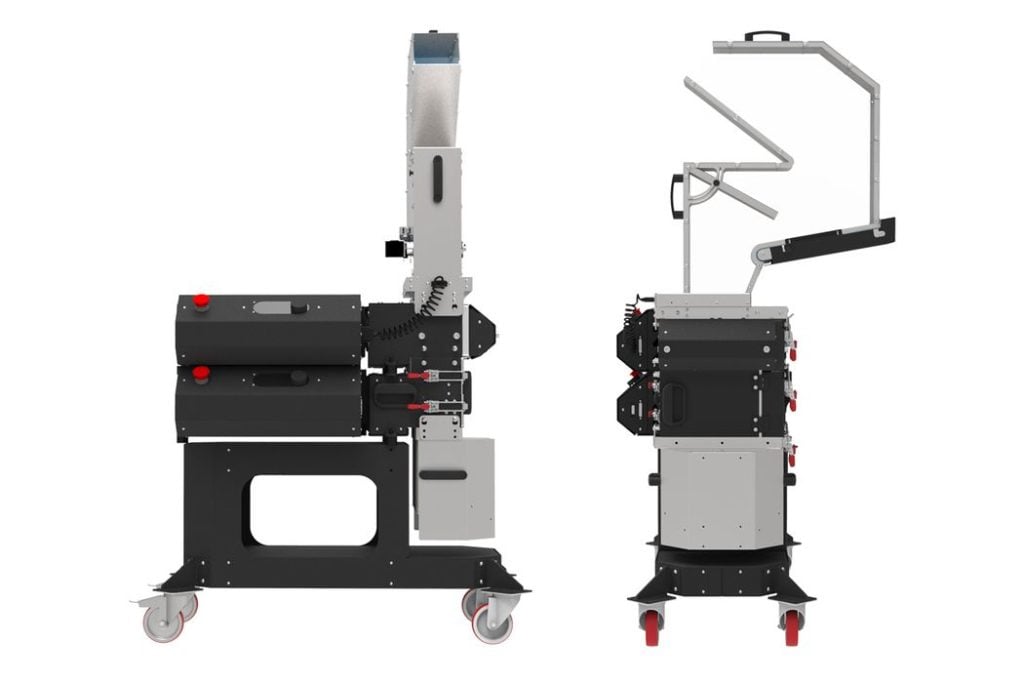
3Devo launched its GP20 Hybrid shredder and granulator in mid-2021. The Netherlands-based company produces a range of desktop equipment capable of shredding plastic waste and producing usable 3D printer filament or granules from it.
The company says its shredder can process:
- Purgings
- Plastic Bags
- Film
- Plastic Bottles
- Glass Fiber Reinforced Plastics
- Carbon Fiber Reinforced Plastics
- 3D-Prints
- Injection Moulded Parts/Waste
The company stopped making its smaller SHR3D IT shredder that was ideal for small office or home use.
Filabot Reclaimer
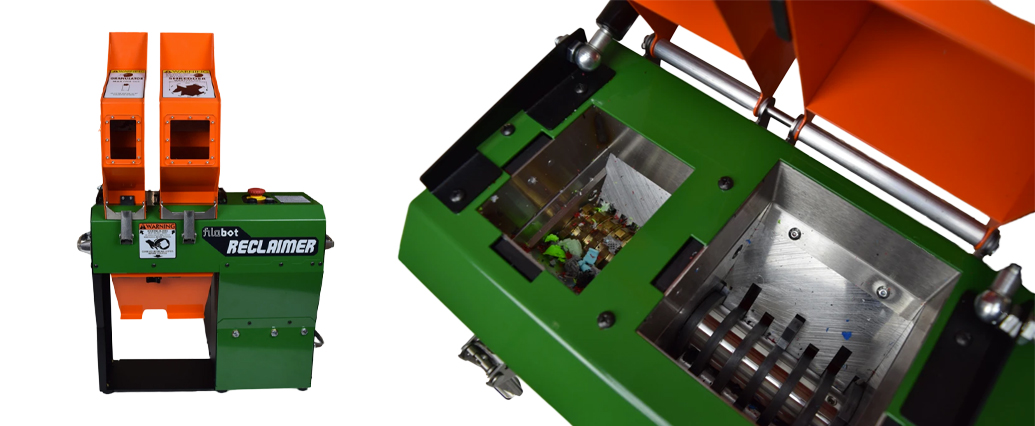
The Filabot Reclaimer is a granulator unit that breaks down plastic, such as failed 3D prints and post-consumer waste plastics, and turns that plastic into particles. These particles can then be processed 3D printing filament with the company extruder machines, or fed directly into a 3D printer with a bulk material feeder.
The Reclaimer has a two-stage breakdown process that can make printable material for nearly any plastic waste. The first stage, the shredder, breaks down large chunks of plastics into smaller pieces, from there the broken down chunks are fed into the granulator that breaks the pieces down to the final extrudable size.
Cost: $5,849
Filament Making Machines
Once you have your recycled plastics chopped up, it’s time to feed them into a filament maker (extruder). Let’s take a look at the most popular machines.
3Devo Filament Makers
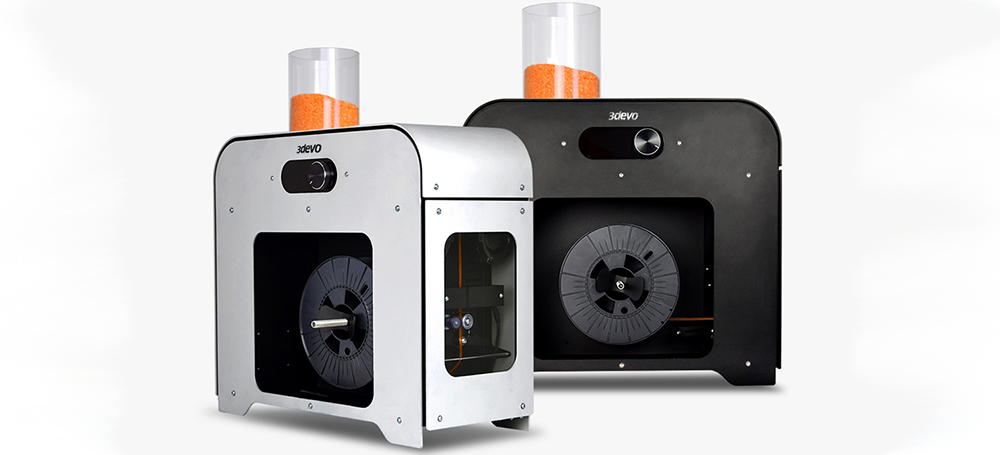
The Composer and Precision Series filament makers from 3Devo are specialized, result-oriented machines with industrial quality power. Making materials simpler than ever to work with, while offering even more possibilities in manufacturing and innovation.
The unique vertical extrusion setup in the filament makers ensures precise roundness and accurately guides the filament to the spool. A dual air cooling system, with adjustable fan speeds and positions, ensures optimal cooling settings for the materials you work with. An optical sensor and a dynamic puller system work together to achieve a diameter precision tolerance of +/- 0.05mm.
Cost: $7,000 – $8,200.
Filabot Filament Extruders
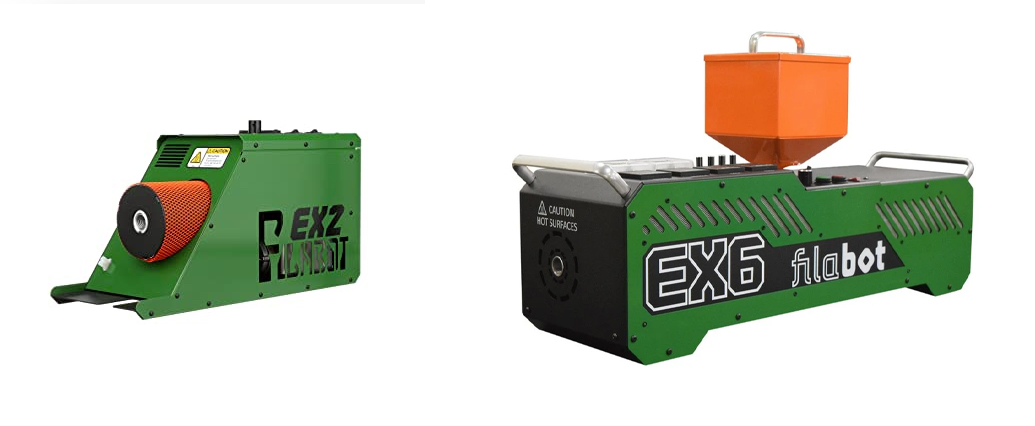
The Filabot EX2 system is the company’s entry-level extrusion system and is designed to be simple for those who are just starting to make filament. The EX2 features a compact three-stage extrusion screw made from hardened and polished high-carbon stainless steel. This proprietary, patent-pending screw is designed to pressurize plastic during the extrusion process, assisting in diameter control and boosting the overall output.
Filabot makes a range of filament extruders and palletizers with the stated goal of enabling people and companies to convert waste plastics into usable filaments, creating a closed-loop cycle. The Filabot EX6 extruder is the professional-level system, while the Filabot Pelletizer ($3,270) is a filament chopper designed to chop filament into pellets.
Cost: $2,747 – $ 10,875.
Redetec's ProtoCycler+

ReDeTec has created patented technology to recycle plastic waste including a 3D printing recycling system called ProtoCycler+. The company says its machine reduces the cost of 3D printing while making printing plastic sustainable.
ProtoCycler+ is a desktop extruder with an Integrated grinder for shredding plastic waste. It features extrusion hardware and digitally regulated filament diameter control, along with software that enables extrusion control when experimenting with polymers and additives.
ReDeTec also sells vibrant colorants and additives to transform your neutral uncolored shreds into a range of vibrant materials.
Cost: $3,500.
Lead image source: Nagami / Ecoalf. Photo by Alfonso Quiroga
License: The text of "3D Printing From Plastic Waste: 12 Successful Recycling Projects" by All3DP Pro is licensed under a Creative Commons Attribution 4.0 International License.
